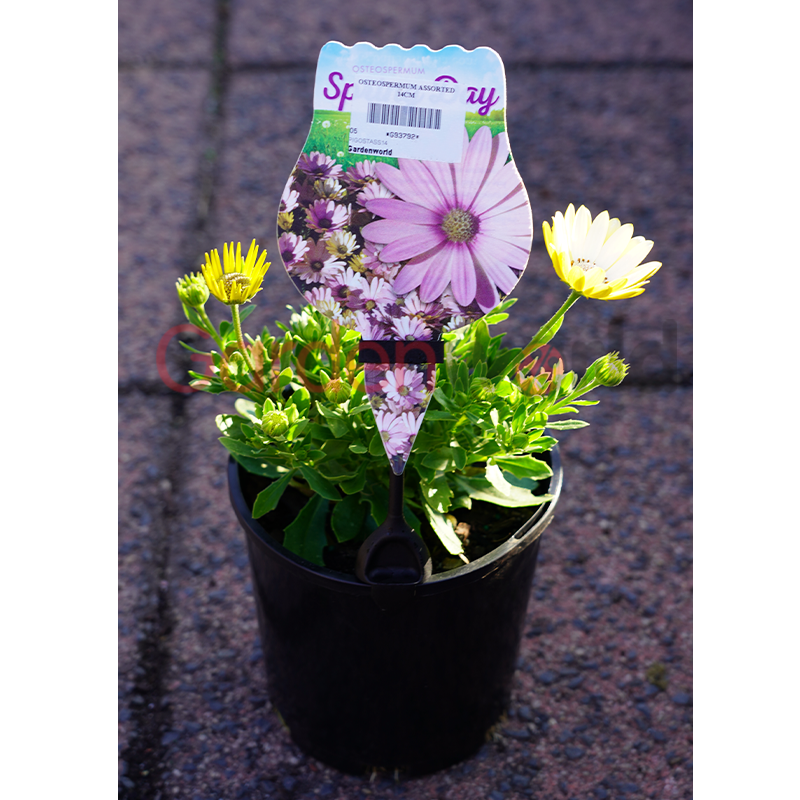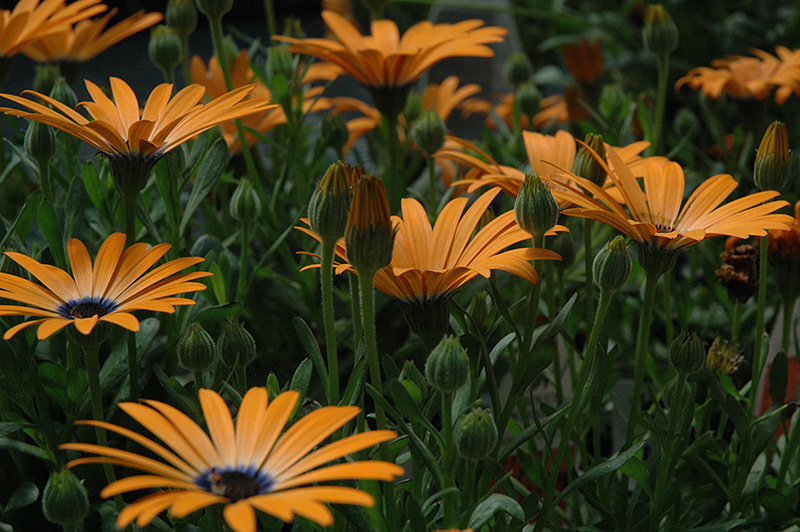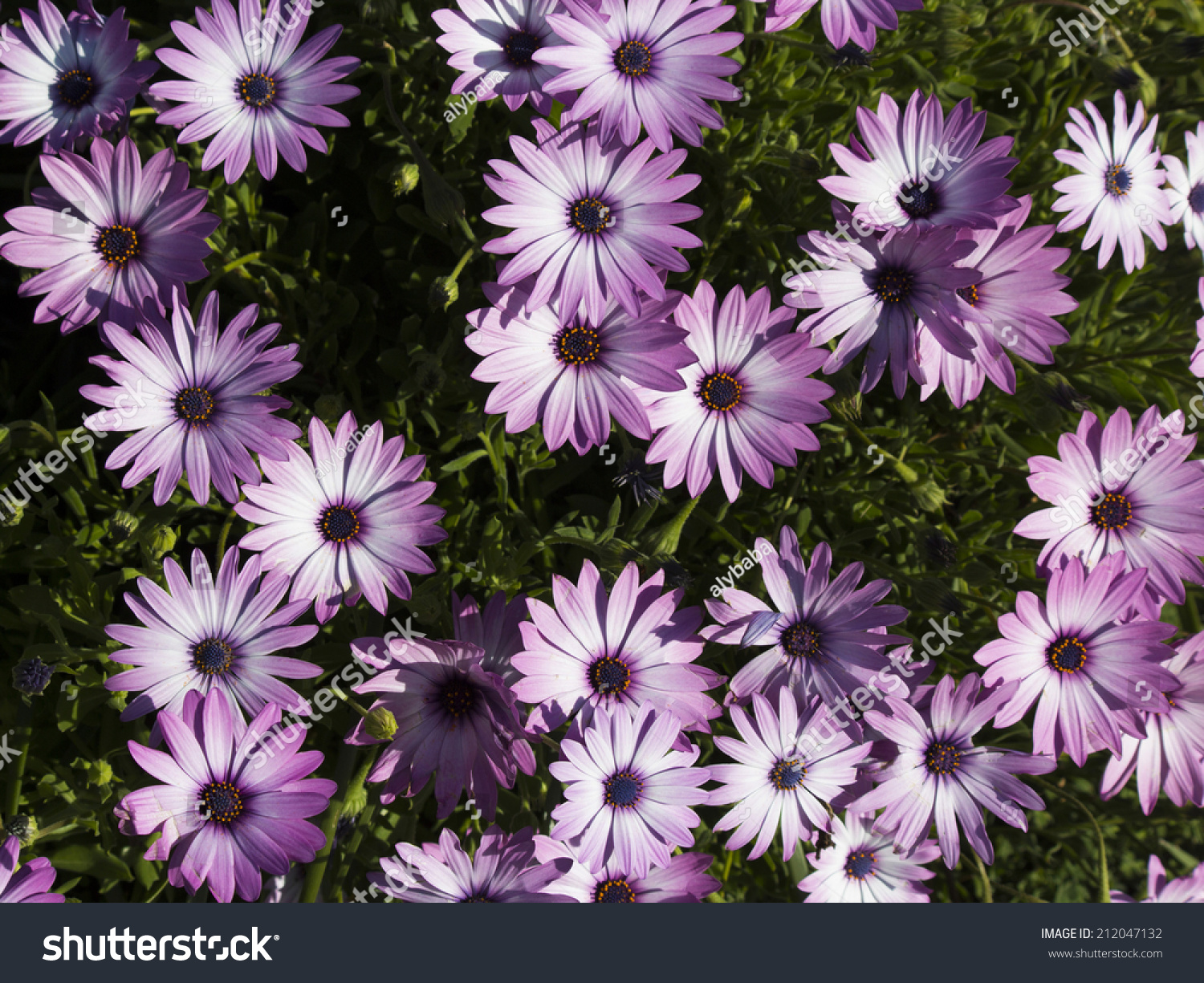The Arctotis is believed to have originated from South Africa. These ornamental plants are part of the daisy family and are fast growing. They need plenty of space to grow as they form an attractive looking carpet.
The arctotis has green grey foliage that is decorated with bright coloured flowers in spring and early summer and can spot flower throughout the year. The leaves of arctotis can reach to a height of 10 to 15 cm that have a wavy edge. The plant will grow at least a metre wide and is very drought and frost hardy and will grow in full sun all day every day. The upper surface of the leaves is grey green sometimes silver grey in colour depending on the cultivar, and the under surface is felted and white. You will find single daisy like flowers 4cm in diameter in bloom on long stems around 16cm long.
The centre of the petals has bright golden yellow centre edged on a black eye. The undersides of the arctotis flower petal are purplish brown in colour. The flowers last for a few days on the bush and can stay fresh in vases for just as long.
The flowers will always close during a cloudy day and at night and reopen when the sun shines. This plant will complete its life cycle in one year or a bit more. Osteospermum () also known as Veldt Daisies, African daisy or Cape Daisy is a bushy evergreen perennial.
It is part of the Asteraceae family and is native to South Africa. It is a low growing spreading shrub that forms a mounding habit. Osteospermum has irregular toothed green foliage and daisy-like flowers. The flowering period begins usually in early Spring and will go until Autumn if some pruning and fertilising occurs and the weather doesn't get too hot during Summer.
These flowers come in a huge assortment of colours and flower styles. The most common colours are shades of pink, purples, yellows, creams, and oranges. Most flowers have a deep violet center however newer hybrids now come with a deep yellow center. Osteospermum prefer a full sun position in the garden and although not picky on the soil type they do require free draining soil.
Once established these plants are drought tolerant and very tough and will tolerate dry soils. Locations with partial-sun exposure still receive about six hours of direct sunlight a day. The best sites are shaded during the hot afternoons. This 6- to 12-inch-tall ground cover spreads up to 36 inches wide and stays evergreen in mild climate areas. "Bronze Carpet" stonecrop (Sedum spurium "Bronze Carpet") produces ground-hugging mates 6 inches tall and 24 inches wide of thick bronze leaves in USDA zones 3 through 9.
This trailing perennial is covered in 9-inch-tall pink flowers throughout the summer. Full-sun sites receive little shade and dry out quickly without a thriving ground cover. "Sunny Amanda" African daisy (Osteospermum "Sunny Amanda") grows best in U.S. The yellow-edged white blossoms appear from spring until the end of fall. The fast-growing plant reaches heights of eighteen inches with long, greenish-blue, fleshy leaves. It produces large, showy, daisy-like flowers in white, deep purple, and lavender, depending upon the variety.
The flowers open during the daylight and close at night and on overcast days. Use it on retaining walls and banks or in borders, raised beds, or containers. Mix in with spring annuals and perennials as a whimsical accent. The trailing African daisy is native to southern Africa and southwestern Arabia. Osteospermum 'Soprano Purple' is a bushy, evergreen, tender perennial with a profusion of rich lavender-purple daisy flowers adorned with sapphire blue eyes. In cool summer climates, these beautiful flowers will produce a long-lasting display from spring to frost.
The blossoms are borne on upright stems clad with lanceolate green leaves. Great for sunny borders and containers where the cheery blooms will bring a pleasing pop of color. With yellow and white or purple flowers which are rich in pollen, this plant is known to attract bees. The underside of the white petals is tinged with blue, while the foliage is green.
This perennial grows best in an area sheltered from the wind. It thrives in full sun and requires well-draining soil. It is not frost-tolerant, so in colder regions, it will need to be kept in a portable pot and be overwintered inside, or alternatively, you can treat it as an annual. The flowers bloom for most of the summer, in July and August. It can grow quite large, up to around four feet in height and three feet in width. This is a genus of daisies that encompasses over 60 species of flowering perennials.
Daisies in this genus are native to dry regions of Southern Africa and are therefore more commonly known as African Daisies. They have typical daisy-shaped flowers, but exist in an array of colors, including orange, yellow, and brown. These daisies are now naturalized in the United States, where many hybrid varieties have been cultivated with an even larger range of color options. Unusually, some species of African Daisies do not have stems, the flower appearing directly among the foliage on the base of the plant.
This species is most commonly known as the Oxeye Daisy but is also sometimes referred to as Dog Daisy or Moon Daisy. It is a pretty grassland perennial, typically growing in meadows, pastures, and wasteland. At around 20 inches tall, the plant is of medium height, with single flowers sprouting from upright stems.
Its toothed foliage is quite distinctive, with leaves being larger at the base of the plant, diminishing in size as they get closer to the top of the stem. The Oxeye Daisy prefers well-draining soil, but it will typically grow anywhere that is not soggy. This plant relies solely on seed to regenerate, though seeds can be successfully sown at any time of year.
The Oxeye Daisy grows quickly compared to other wildflowers, but it lacks staying power, usually dying off after two or three years. Full-shade areas include locations along buildings and underneath overhangs. Wild Ginger grows 10 inches tall spreading 36 inches wide with 3-inch-wide dark green, heart-shaped leaves and reddish flowers in USDA zones 8 through 10.
As well as tender varieties you will also find half hardy cultivars. Half hardy osteospermum plants are a better choice for growers in cooler areas. While these flowers are typically grown as annuals, planting in pots enables you to take the plants undercover in the fall and overwinter.
African daisy flowers come in a range of eye-catching colors, including shades of purple, white, yellow and orange. You can find seed packets of the osteospermum passion mix which blends white, pink, and purple blooming flowers in one mixture. While they abhor cold, if you need a drought hearty, or heat-resistant flower, it is the daisy. The same cultivar also comes in a copper and apricot-colored variety with bi-colored flowers. This particular cultivar can grow well in partial shade or full sun. Angelonia is also called summer snapdragon, and once you get a good look at it, you'll know why.
It has flower spires that reach a foot or two high, but they're studded with fascinating snapdragon-like flowers with beautiful colorations in purple, white, or pink. It's the perfect plant for adding bright color to hot, sunny spaces, where it will bloom all summer long. While all varieties are beautiful, keep an eye out for the sweetly scented selections. While most gardeners treat angelonia as an annual, it is perennial in Zones 9-10. Or, if you have a bright, sunny spot indoors, you can keep it flowering all winter.
Arctotis belongs to the family Asteraceae and are annual and perennial plants. These plants are attractive flowering plants that will suit many garden landscapes. The flowers will close in during the afternoon and also in dull weather.
Nowadays, there are plenty of contrasting cultivars available that are made for garden use. The Arctotis flowers come in a wide variety of shades of yellow, pink, and red, white, gold shades and sometimes are blue eyed. They are suited to grow and be used in gardens as container and bedding plants. These hardy Osteospermum make superb flowering ground cover are striking hardy perennials.
Originating from Africa, they prefer to be in full sun with dry but well-drained soil. They produce their flowers from late Spring to late Autumn and have intensely fragrant and evergreen upright foliage with vibrant and showy daisy-like blooms. They make great front of border plants and them in pots and containers, perhaps planted with Grasses, Hardy Geraniums and eryngium. Filtered shade is found under trees and bush where the sun beams dance around on the ground.
Silver cloak ferns stay close to the ground with 6-inch-tall upright fronds with green topsides and white undersides. In USDA plant hardiness zones 5 to 9, this deciduous ground cover fills in the area through creep roots. This African-originated perennial groundcover is recognized for its large orange, yellow, pink or red flowers with dark centers surrounded by an orange ring. It enjoys full sun, doesn't require much water and often blooms from spring to summer.
Spreading low on the ground under 1 foot tall, arctotis acaulis can spread 2-3 feet, making it a great plant to cover large areas. Are you thinking about adding daisies to your garden this spring? If so, you're in luck as daisies are some of the easiest flowers to grow. Commonly grown from seeds, daisies can be planted directly into your flowerbeds. Besides ample sunlight and a well-draining soil, daisies don't need much to thrive, making them one of the best low-maintenance flowers. Daisies love the sun, making them one of the best full-sun flowers and aren't usually bothered by insects or disease.
For best results, plant yours in a nutrient-rich, well-draining soil with seeds about 9 to 12 inches apart. They can be grown in both full sun or partial sun locations but will not tolerate overwatering. Keep the soil they grow in topped up with organic matter to help them thrive. These plants don't last very long, flowering for only a few years in a row. To keep your Shasta Daisies continually appearing, introduce new plants to your garden every year. Aside from deadheading spent flowers, this plant requires very little maintenance.
Once flowers have ceased production in late summer or early fall, you can drastically cut foliage back to help encourage growth next year. Early spring or after the blooms in autumn is the best time to cut back hardy Osteospermums. You need to water your Osteospermums regularly to keep them healthy, try to avoid allowing them to dry out. It is beneficial to cut back Osteospermums to around 3 inches in height before new growth begins in early spring for hardier varieties. If the old foliage is removed, the plant will be encouraged to grow new growth.
Originally from southern Africa, the African continent in general, and parts of the Arabian Peninsula where they grow in veldts and grasslands. A large variety of plants were introduced to Europe in the 19th Century and cultivated there ever since. African Daisy flowers face the sun by nature, so they are phototropic. The flowers close up when the sky is heavily clouded and at night. I mixed two bright lights - pink and yellow and white.I have them planted with million bells, purple fountain grass, and blue Mohawk grass in multi colored containers.
They have many blooms and continue to produce blooms when the flowers self-deadhead. I'm sad that they are annuals and am trying to figure out how to save them during the winter. It is a graceful trailing plant that grows inches long. It has dainty flower heads that are 3/4 of an inch across with numerous white or pinkish rays. Use as ground cover in garden beds or large containers, in rock gardens, in hanging baskets, and on dry walls. African daisies (Osteospermum spp.) look a lot like common daisies, with petals radiating around a center disk.
They are even in the Asteraceae family, along with shasta daisies and zinnias. But their vivid coloring is not at all like the classic daisy. In fact, when African daisies were first introduced to the market, some people thought they must have been dyed.
The center disks of the flowers even can look like they're colored with metallic paint. The leaves vary by variety; they can be lance-like or broadly ovate and smooth, toothed, or lobed. Petals can be smooth and flat like a typical daisy, or they can radiate out in a tubular spoon shape. These flowers are best planted in the spring after the threat of frost has passed, and they have a fairly quick growth rate, blooming about two months after planting.
The trailing African daisy should be planted in full sun to partial shade. Give this groundcover ample to moderate water but do not over-water it. The plant takes any soil but prefers those that are well-draining.


























No comments:
Post a Comment
Note: Only a member of this blog may post a comment.